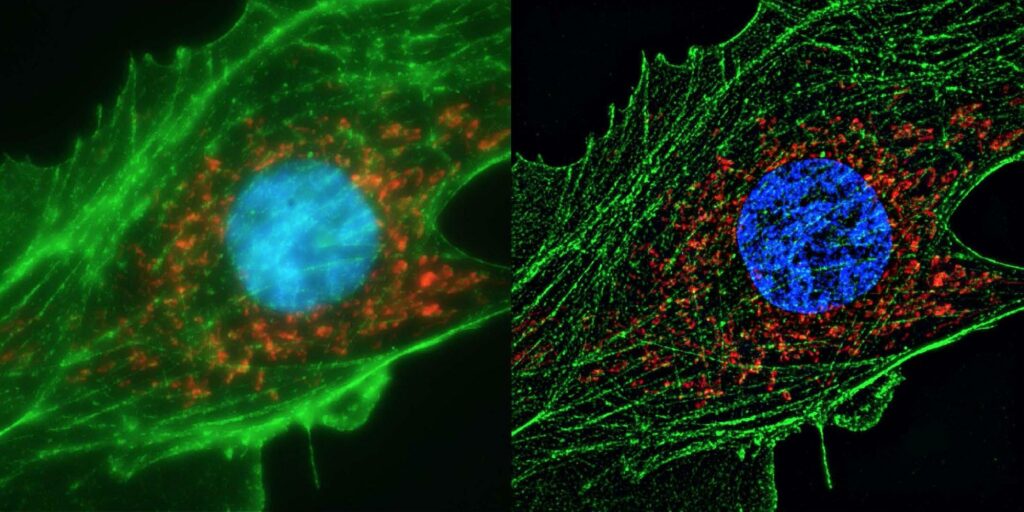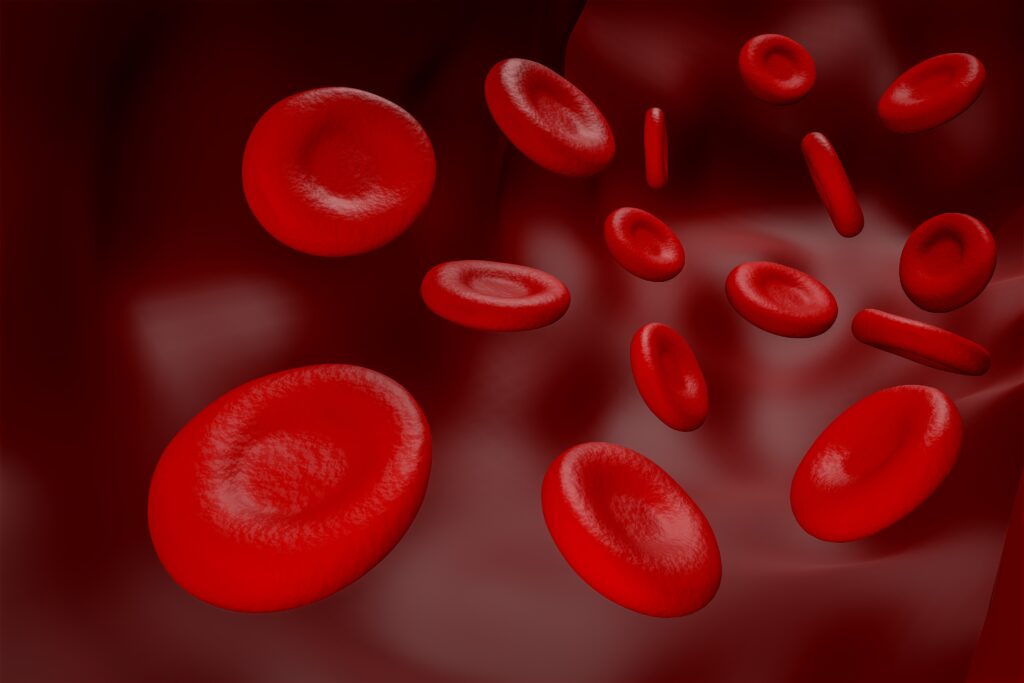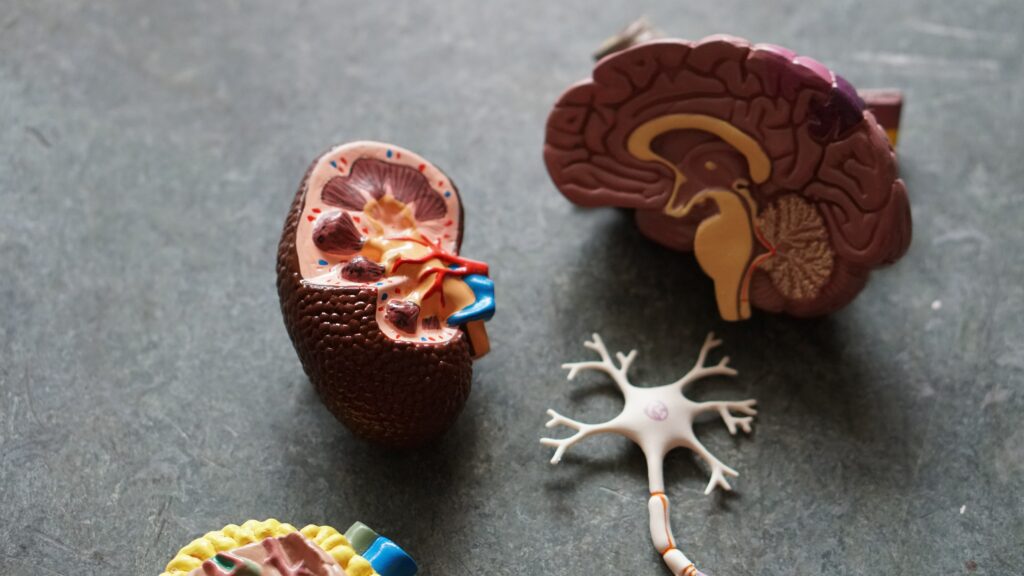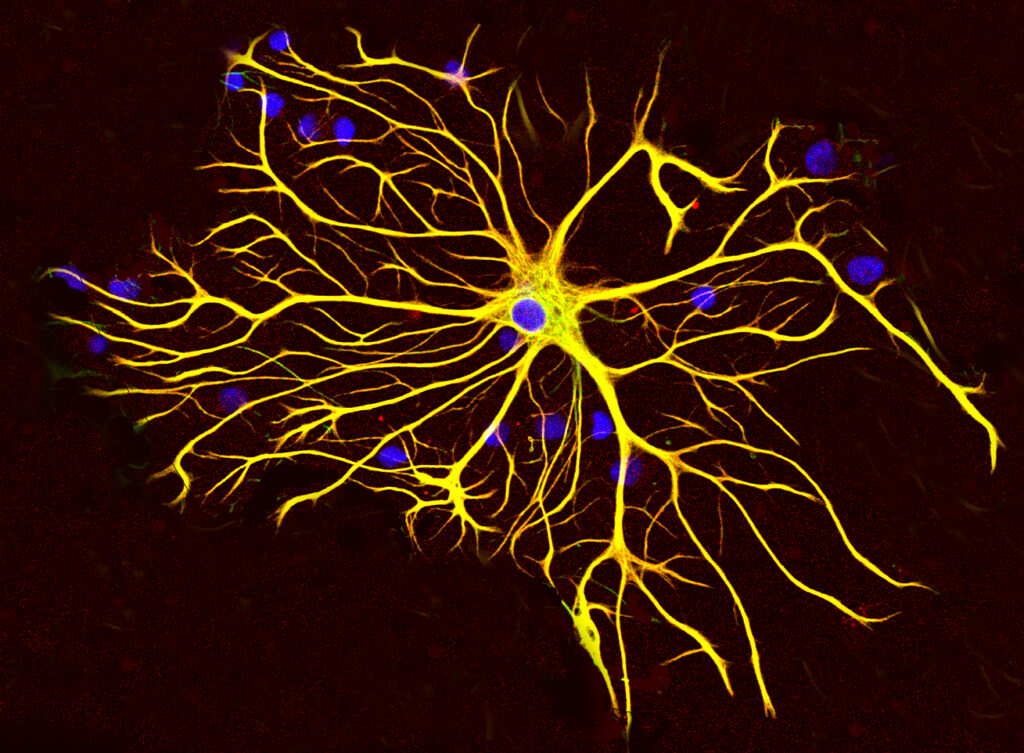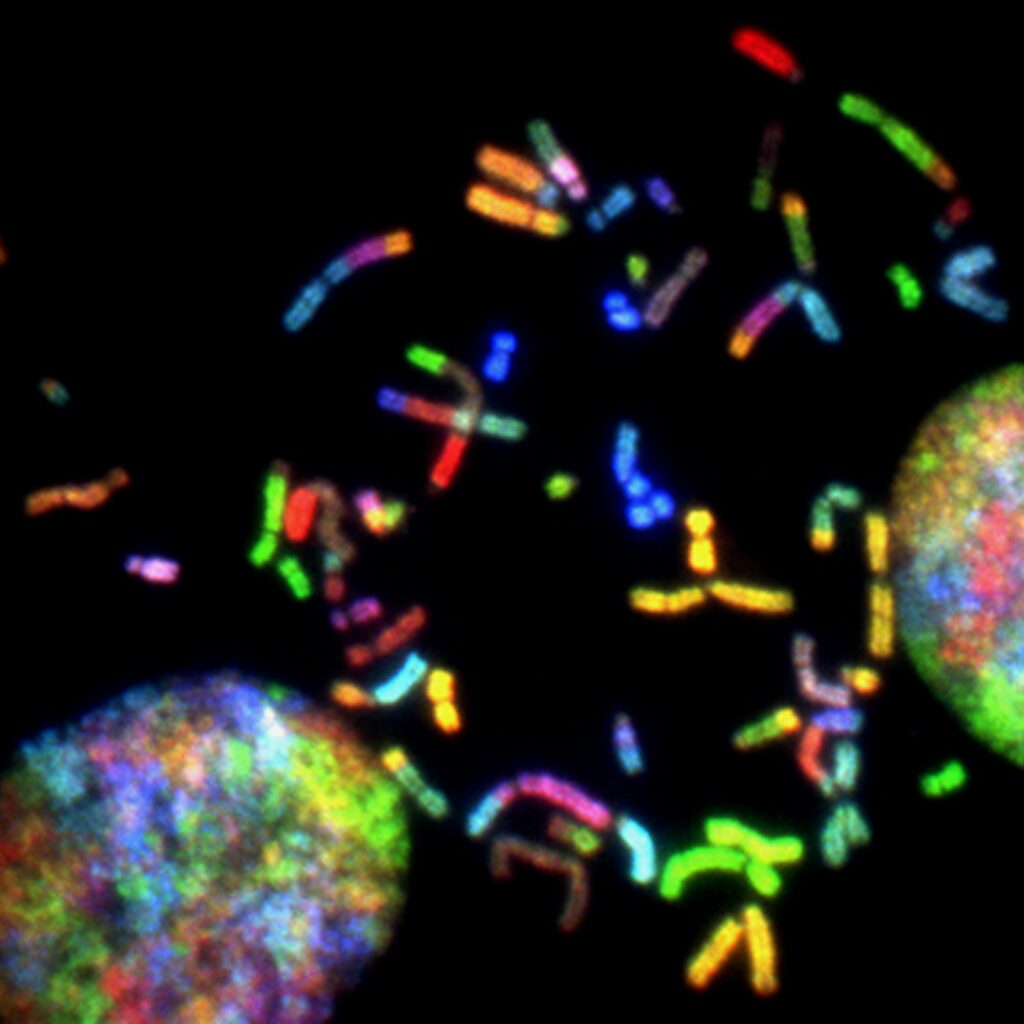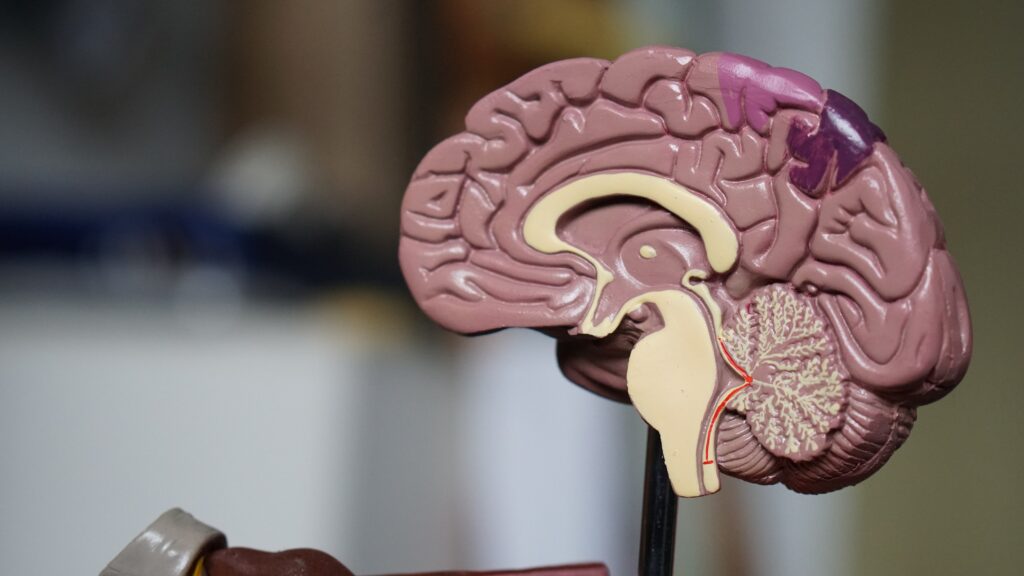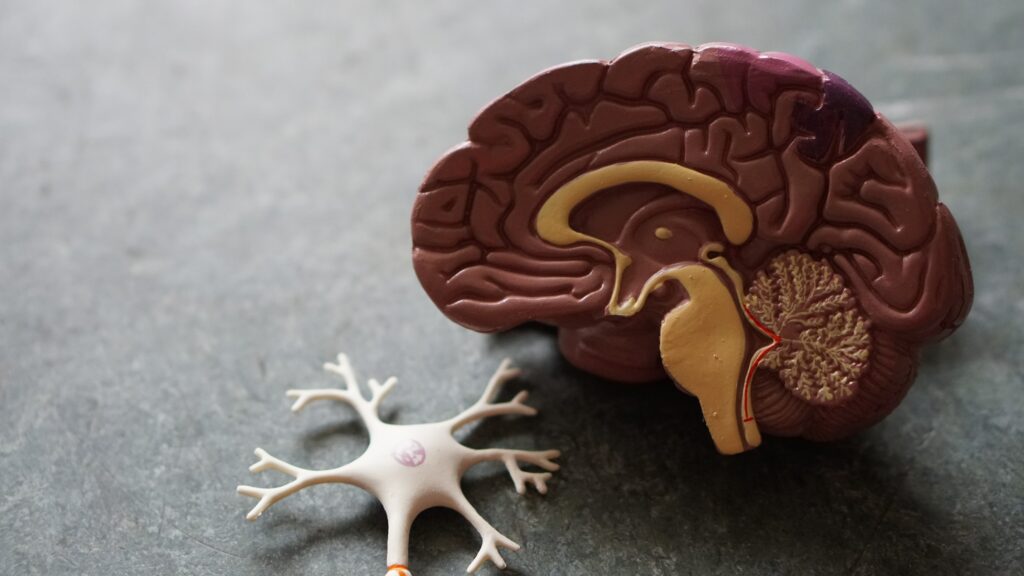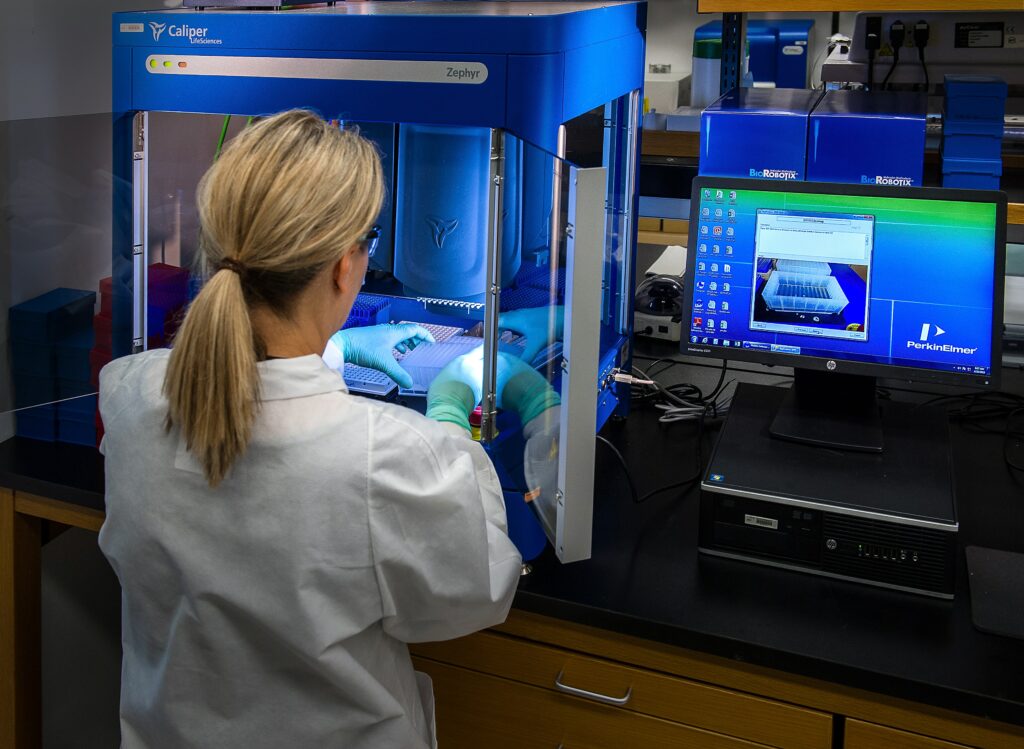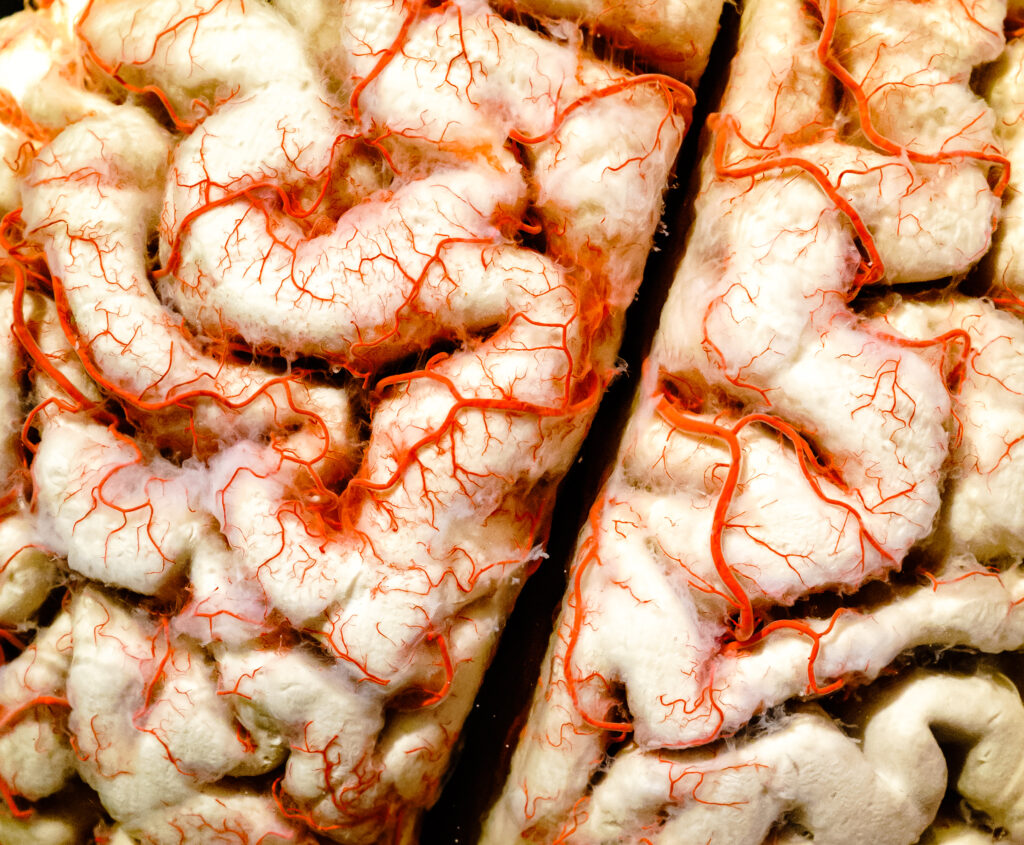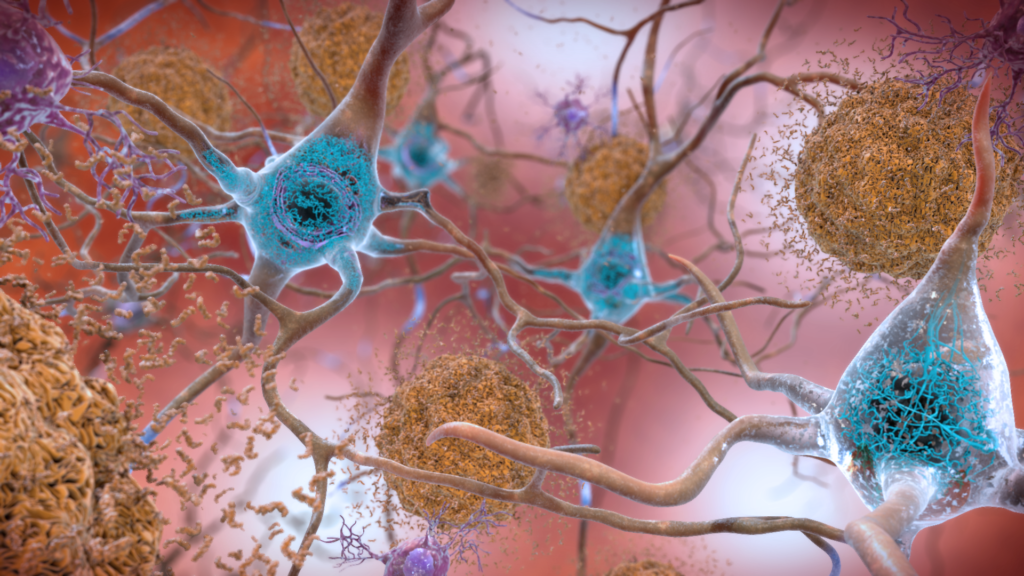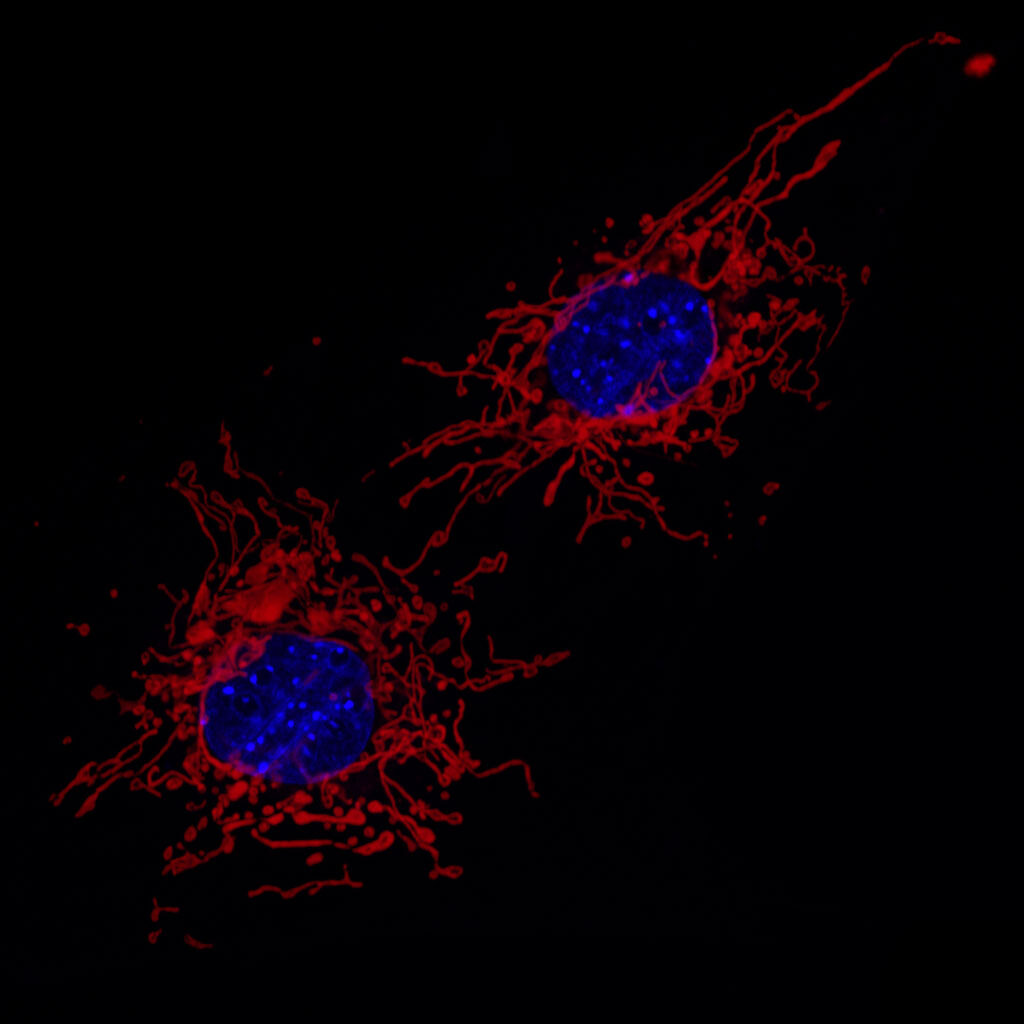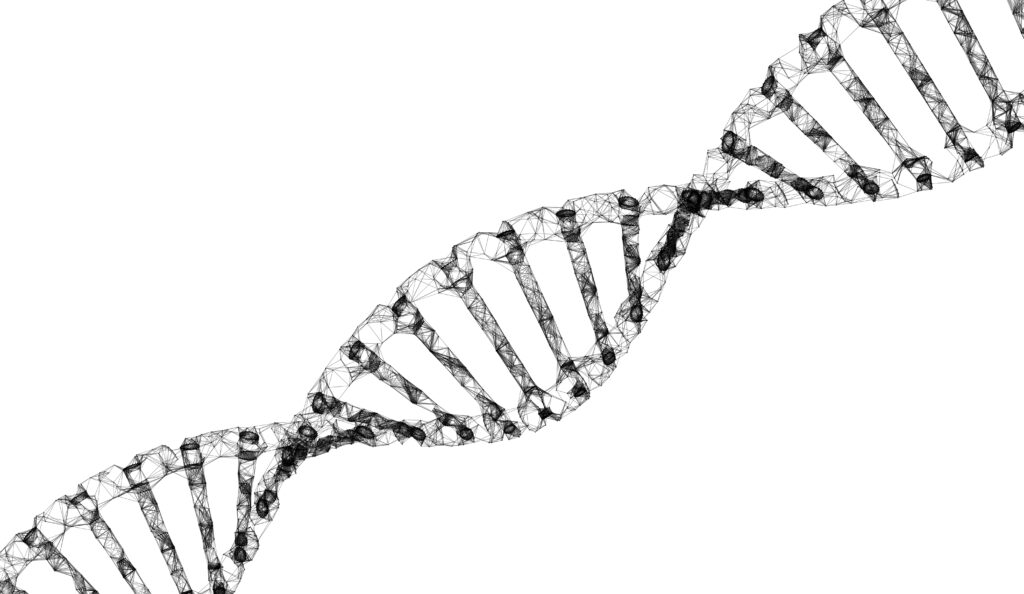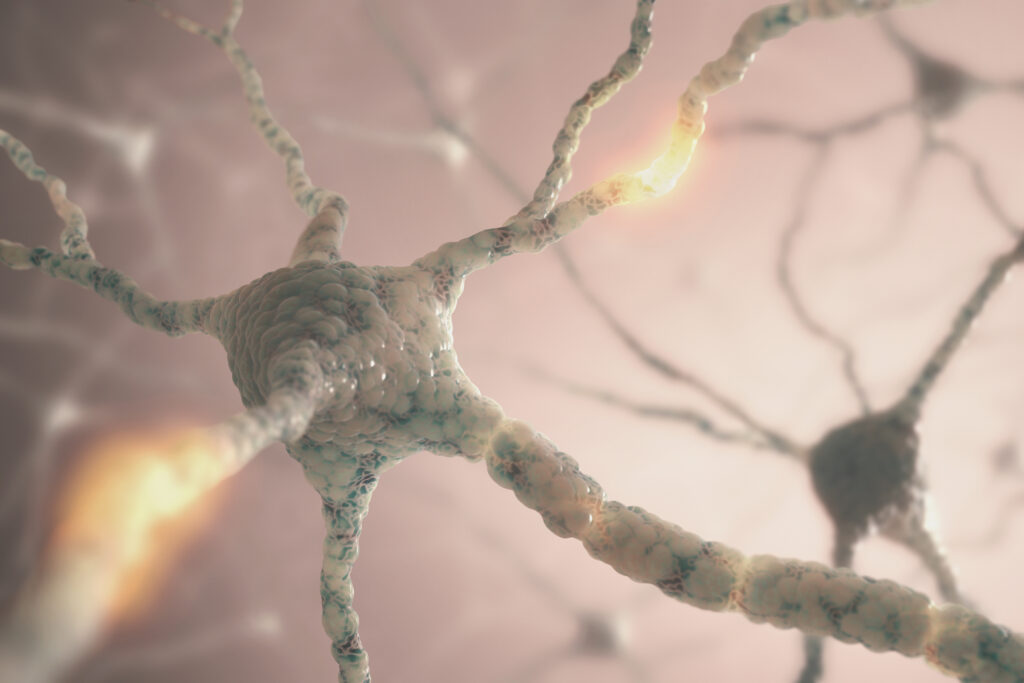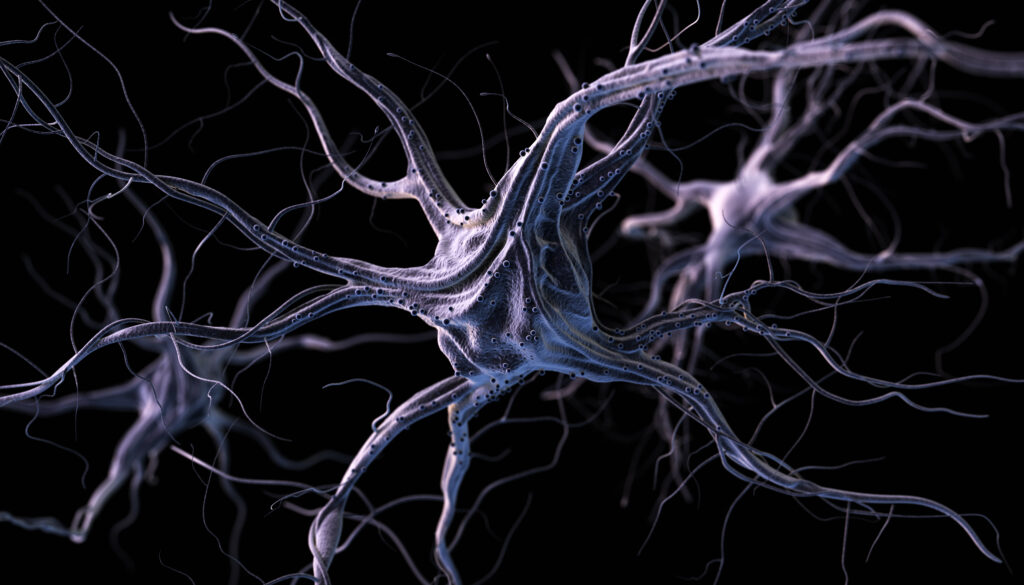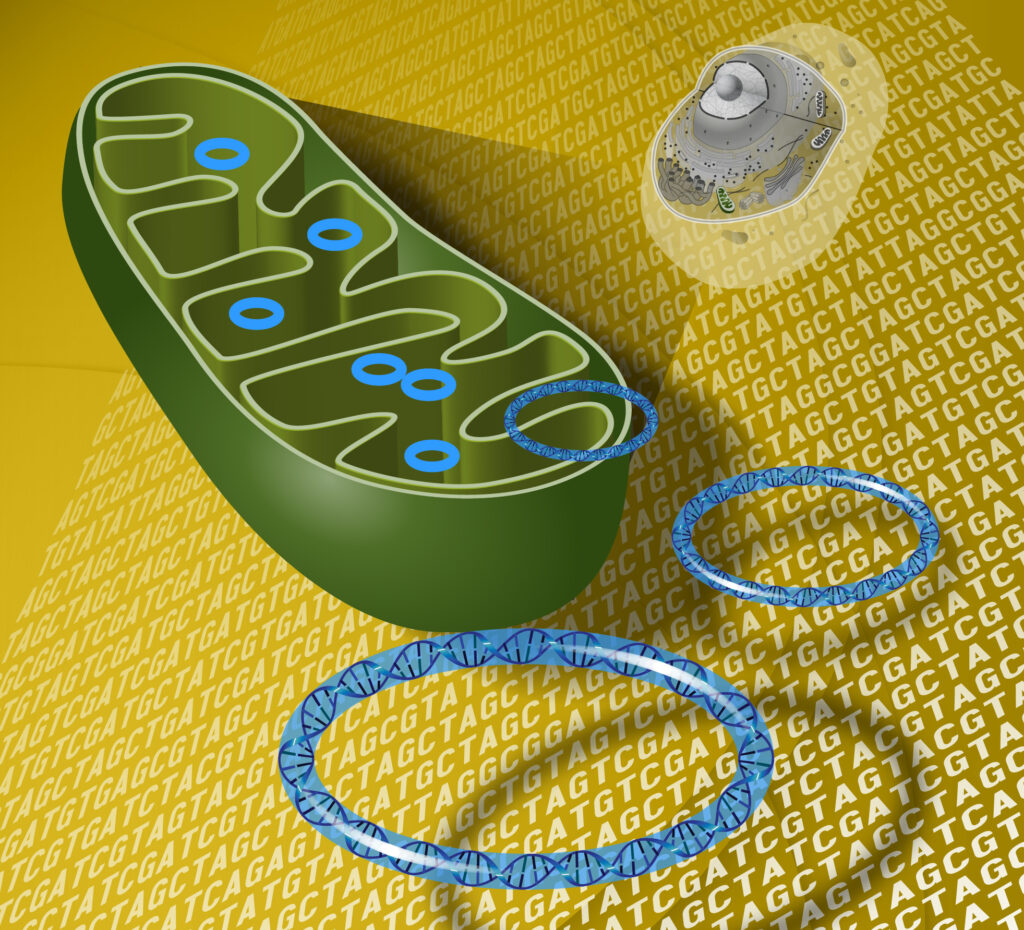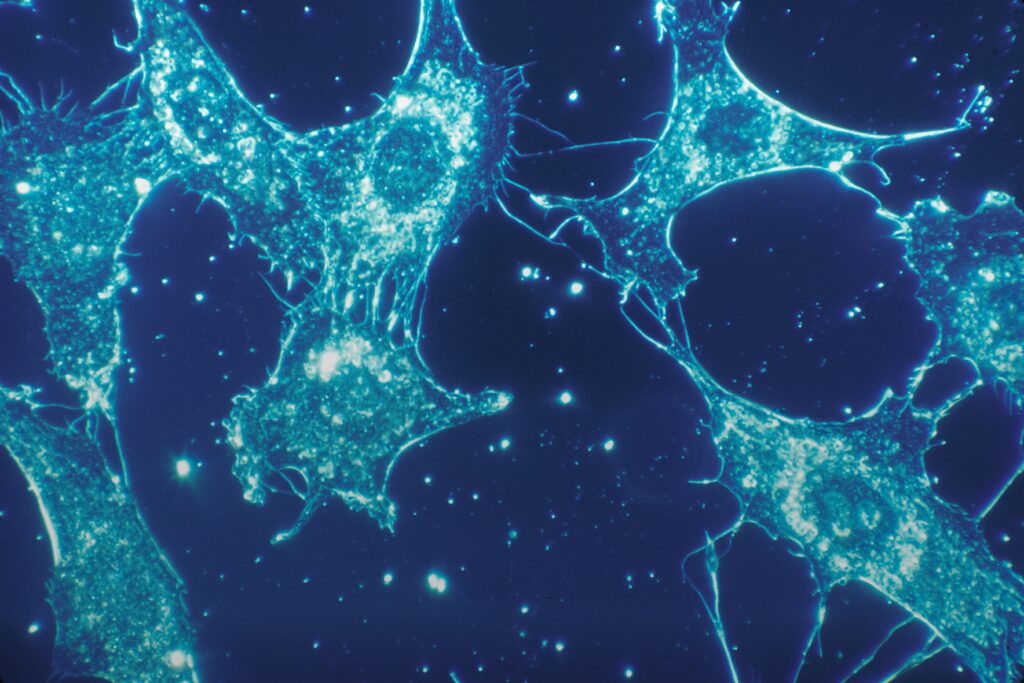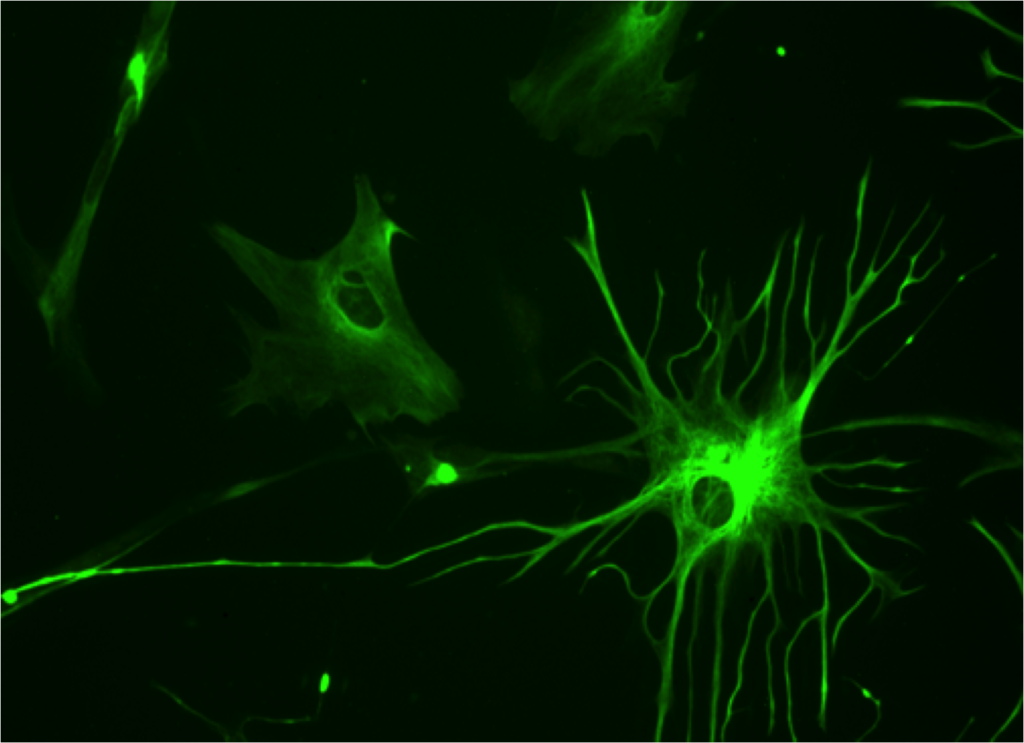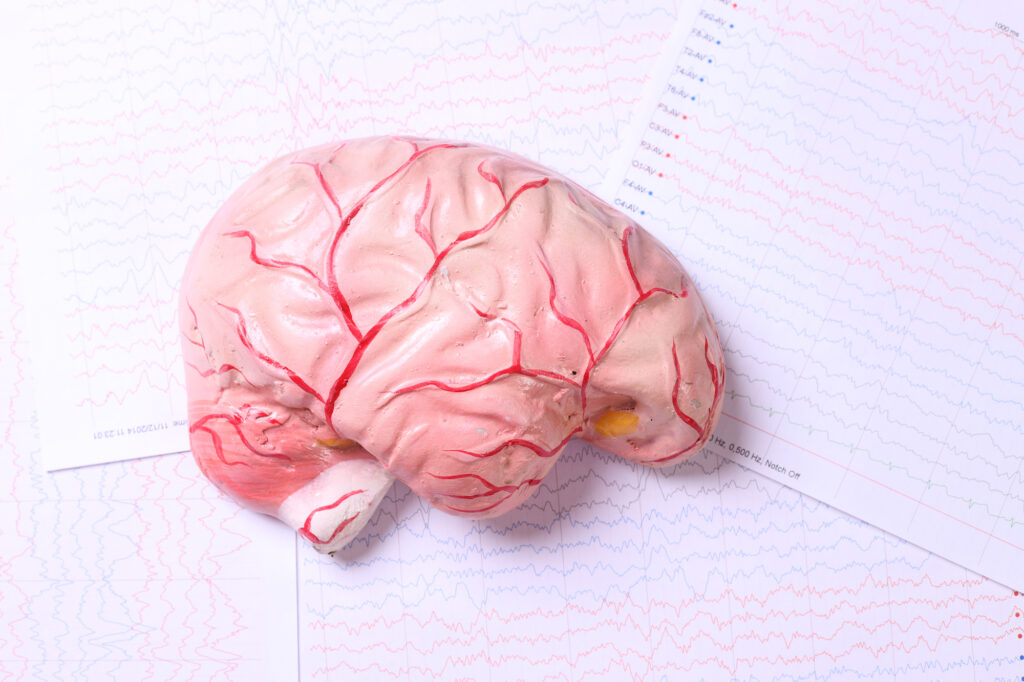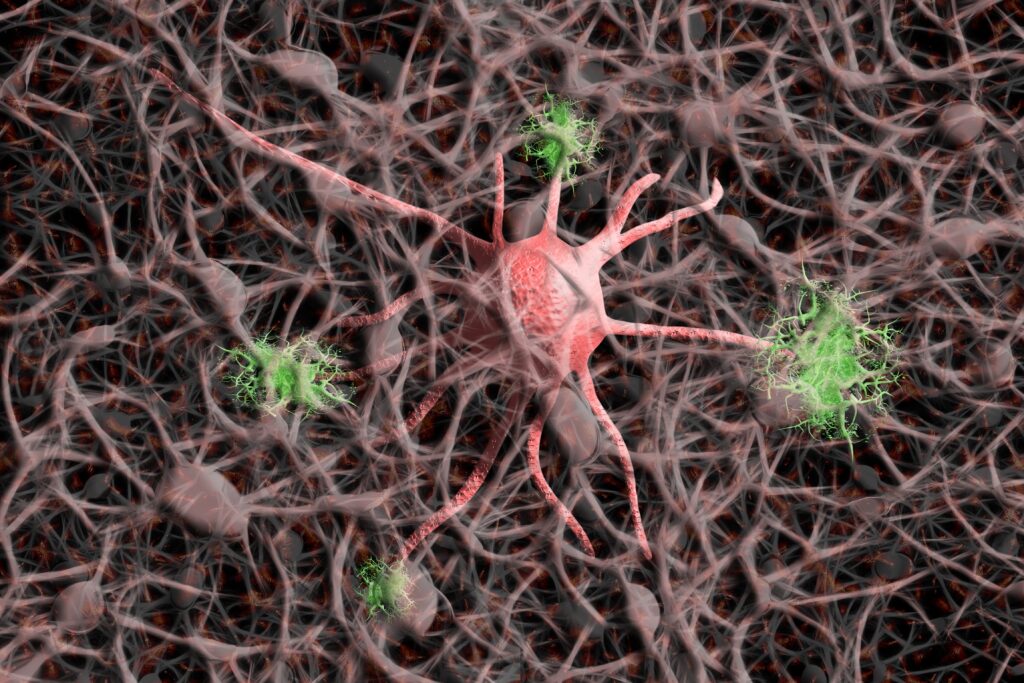Published research to date related to Sigma proteins and Alzheimer’s disease has been conducted with compounds not developed by Advantx Pharmaceuticals Inc. Our therapeutic candidates ADV462 EAD and ADV368 LAD for Alzheimer’s disease are the first pharmaceutical-grade selective compounds in development with novel molecules targeting the Sigma-2 receptor with unambiguous antagonist activity, and in the case of ADV368, in a single bispecific molecule, also the Sigma-1 receptor with agonist activity.
RECENT SCIENTIFIC PUBLICATIONS RELATED TO SIGMA RECEPTORS AND ALZHEIMER'S DISEASE
N, N-Dimethyltryptamine, a natural hallucinogen, ameliorates Alzheimer’s disease by restoring neuronal Sigma-1 receptor-mediated endoplasmic reticulum-mitochondria crosstalk
By Dan Cheng, Zhuo-Gui Lei, Kin Chu, Oi Jin Honey Lam, Chun Yuan Chiang, and Zhang-Jin Zhang Excerpt from the article published in Alzheimer’s Research & Therapy volume 16, 95, 01 May 2024, DOI: https://doi.org/10.1186/s13195-024-01462-3 Abstract Background Aberrant neuronal Sigma-1 receptor (Sig-1r)-mediated endoplasmic reticulum (ER)- mitochondria signaling plays a key role in the neuronal cytopathology […]
Transmembrane protein 97 is a potential synaptic amyloid beta receptor in human Alzheimer’s disease
By Martí Colom-Cadena, Jamie Toombs, Elizabeth Simzer, Kristjan Holt, Robert McGeachan, Jane Tulloch, Rosemary J. Jackson, James H. Catterson, Maxwell P. Spires-Jones, Jamie Rose, Lora Waybright, Anthony O. Caggiano, Declan King, Francesco Gobbo, Caitlin Davies, Monique Hooley, Sophie Dunnett, Robert Tempelaar, Soraya Meftah, Makis Tzioras, Mary E. Hamby, Nicholas J. Izzo, Susan M. Catalano, Claire […]
Synaptic oligomeric tau in Alzheimer’s disease — A potential culprit in the spread of tau pathology through the brain
By Martí Colom-Cadena, Caitlin Davies, Sònia Sirisi, Ji-Eun Lee, Elizabeth M. Simzer, Makis Tzioras, Marta Querol-Vilaseca, Érika Sánchez-Aced, Ya Yin Chang, Kristjan Holt, Robert I. McGeachan, Jamie Rose, Jane Tulloch, Lewis Wilkins, Colin Smith, Teodora Andrian et al. Excerpt from the article published in Neuron, Elsevier, May 15, 2023, DOI: https://doi.org/10.1016/j.neuron.2023.04.020 Highlights Summary In Alzheimer’s […]
Abundant Aβ fibrils in ultracentrifugal supernatants of aqueous extracts from Alzheimer’s disease brains
By Andrew M. Stern,Yang Yang,Shanxue Jin,Keitaro Yamashita,Angela L. Meunier,Wen Liu,Yuqi Cai,Maria Ericsson,Lei Liu,Michel Goedert,Sjors H.W. Scheres, and Dennis J. Selkoe Excerpt from the article published in Neuron, May 10, 2023 DOI: https://doi.org/10.1016/j.neuron.2023.04.007 Highlights Summary Soluble oligomers of amyloid β-protein (Aβ) have been defined as aggregates in supernatants following ultracentrifugation of aqueous extracts from Alzheimer’s disease […]
SIGMAR1 Confers Innate Resilience against Neurodegeneration
By Simon Couly, Yuko Yasui, and Tsung-Ping Su Excerpt from the article published in the International Journal of Molecular Sciences 24, no. 9: 7767. 24 April 2023, DOI: https://doi.org/10.3390/ijms24097767 Abstract The sigma-1 receptor (SIGMAR1) is one of a kind: a receptor chaperone protein. This 223 amino acid-long protein is enriched at the mitochondria-associated endoplasmic reticulum membrane […]
Sigma-2 Receptors—From Basic Biology to Therapeutic Target: A Focus on Age-Related Degenerative Diseases
By Britney N. Lizama, Jennifer Kahle, Susan M. Catalano, Anthony O. Caggiano, Michael Grundman, and Mary E. Hamby Excerpt from the article published in the International Journal of Molecular Sciences. 24(7):6251. 26 March 2023. DOI: https://doi.org/10.3390/ijms24076251 Editor’s Highlights Abstract There is a large unmet medical need to develop disease-modifying treatment options for individuals with age-related […]
Overview of Sigma-1R Subcellular Specific Biological Functions and Role in Neuroprotection
By Véronik Lachance, Sara-Maude Bélanger, Célia Hay, Victoria Le Corvec, Vina Banouvong, Mathieu Lapalme, Khadija Tarmoun, Guillaume Beaucaire, Marc P. Lussier, and Saïd Kourrich Excerpt from the article published in the International Journal of Molecular Sciences. 19 January 2023; 24(3):1971. DOI: https://doi.org/10.3390/ijms24031971 Editor’s Highlights Abstract For the past several years, fundamental research on Sigma-1R (S1R) […]
Aβ efflux impairment and inflammation linked to cerebrovascular accumulation of amyloid-forming amylin secreted from pancreas
By Nirmal Verma, Gopal Viswanathan Velmurugan, Edric Winford, Han Coburn, Deepak Kotiya, Noah Leibold, Laura Radulescu, Sanda Despa, Kuey C. Chen, Linda J. Van Eldik, Peter T. Nelson, Donna M. Wilcock, Gregory A. Jicha, Ann M. Stowe, Larry B. Goldstein, David K. Powel, Jeffrey H. Walton, Manuel F. Navedo, Matthew A. Nystoriak, Andrew J. Murray, […]
Chaperone-Dependent Mechanisms as a Pharmacological Target for Neuroprotection
By Mikhail V. Voronin, Elena V. Abramova, Ekaterina R. Verbovaya, Yulia V. Vakhitova, and Sergei B. Seredenin Excerpt from the article published in International Journal of Molecular Sciences 24, no. 1: 823. 3 January 2023, DOI: https://doi.org/10.3390/ijms24010823 Editor’s Highlights Abstract Modern pharmacotherapy of neurodegenerative diseases is predominantly symptomatic and does not allow vicious circles causing disease […]
Brain-derived tau: a novel blood-based biomarker for Alzheimer’s disease-type neurodegeneration
By Fernando Gonzalez-Ortiz, Michael Turton, Przemysław R Kac, Denis Smirnov, Enrico Premi, Roberta Ghidoni, Luisa Benussi, Valentina Cantoni, Claudia Saraceno, Jasmine Rivolta, Nicholas J Ashton, Barbara Borroni, Douglas Galasko, Peter Harrison, Henrik Zetterberg, Kaj Blennow, and Thomas K Karikari Excerpt from the article published in Brain, 27 December 2022; awac407, DOI: https://doi.org/10.1093/brain/awac407 Editor’s Highlights Abstract Blood-based […]
Decoding the heterogeneity of Alzheimer’s disease diagnosis and progression using multilayer networks
By Bárbara Avelar-Pereira, Michael E. Belloy, Ruth O’Hara, and S. M. Hadi Hosseini for the Alzheimer’s Disease Neuroimaging Initiative Excerpt from the article published in Molecular Psychiatry. 20 December 2022, DOI: https://doi.org/10.1038/s41380-022-01886-z Editor’s Highlights Abstract Alzheimer’s disease (AD) is a multifactorial and heterogeneous disorder, which makes early detection a challenge. Studies have attempted to combine […]
Neuroinflammation is independently associated with brain network dysfunction in Alzheimer’s disease
By Fangda Leng, Rainer Hinz, Steve Gentleman, Adam Hampshire, Melanie Dani, David J. Brooks, and Paul Edison Excerpt from the article published in Molecular Psychiatry, 06 December 2022. DOI: https://doi.org/10.1038/s41380-022-01878-z Editor’s Highlights Abstract Brain network dysfunction is increasingly recognised in Alzheimer’s disease (AD). However, the causes of brain connectivity disruption are still poorly understood. Recently, […]
Reduced excitatory neuron activity and interneuron-type-specific deficits in a mouse model of Alzheimer’s disease
By Moustafa Algamal, Alyssa N. Russ, Morgan R. Miller, Steven S. Hou, Megi Maci, Leon P. Munting, Qiuchen Zhao, Dmitry Gerashchenko, Brian J. Bacskai, and Ksenia V. Kastanenka Excerpt from the article published in Communications Biology 5, 1323, 02 December 2022. DOI: https://doi.org/10.1038/s42003-022-04268-x Editor’s Highlights Abstract Alzheimer’s disease (AD) is characterized by progressive memory loss […]
PLD3 affects axonal spheroids and network defects in Alzheimer’s disease
By Peng Yuan, Mengyang Zhang, Lei Tong, Thomas M. Morse, Robert A. McDougal, Hui Ding, Diane Chan, Yifei Cai, and Jaime Grutzendler Excerpt from the article published in Nature, 30 November 2022. DOI: https://doi.org/10.1038/s41586-022-05491-6 Editor’s Highlights Abstract The precise mechanisms that lead to cognitive decline in Alzheimer’s disease are unknown. Here we identify amyloid-plaque-associated axonal […]
Mitochondrial Ca2+ Signaling and Bioenergetics in Alzheimer’s Disease
By Nikita Arnst, Nelly Redolfi, Annamaria Lia, Martina Bedetta, Elisa Greotti, and Paola Pizzo Excerpt from the article Biomedicines 10, no. 12: 3025. 24 November 2022. DOI: https://doi.org/10.3390/biomedicines10123025 Editor’s Highlights Abstract Alzheimer’s disease (AD) is a hereditary and sporadic neurodegenerative illness defined by the gradual and cumulative loss of neurons in specific brain areas. The processes […]
ApoE in Alzheimer’s disease: pathophysiology and therapeutic strategies
By Ana-Caroline Raulin, Sydney V. Doss, Zachary A. Trottier, Tadafumi C. Ikezu, Guojun Bu, and Chia-Chen Liu Excerpt from the article published in Molecular Neurodegeneration 17, 72, 8 November 2022, DOI: https://doi.org/10.1186/s13024-022-00574-4 Editor’s Highlights Abstract Alzheimer’s disease (AD) is the most common cause of dementia worldwide, and its prevalence is rapidly increasing due to extended lifespans. […]
Amyloid-associated increases in soluble tau relate to tau aggregation rates and cognitive decline in early Alzheimer’s disease
By Alexa Pichet Binette, Nicolai Franzmeier, Nicola Spotorno, Michael Ewers, Matthias Brendel, Davina Biel, Olof Strandberg, Shorena Janelidze, Sebastian Palmqvist, Niklas Mattsson-Carlgren, Ruben Smith, Erik Stomrud, Rik Ossenkoppele, and Oskar Hansson Excerpt from the article published in Nature Communications 13, 6635, 04 November 2022. DOI: https://doi.org/10.1038/s41467-022-34129-4 Editor’s Highlights Abstract For optimal design of anti-amyloid-β (Aβ) […]
The synergy of β amyloid 1-42 and oxidative stress in the development of Alzheimer’s disease-like neurodegeneration of hippocampal cells
By Gohar Karapetyan, Katarine Fereshetyan, Hayk Harutyunyan, and Konstantin Yenkoyan Excerpt from the article published in Scientific Reports 12, 17883, 25 October 2022. DOI: https://doi.org/10.1038/s41598-022-22761-5 Editor’s Highlights Alzheimer’s disease (AD) is a neurodegenerative disease that occurs in elderly individuals and which incidence has increased year by year, and there is still no effective drug for treating […]
Protein synthesis inhibition and loss of homeostatic functions in astrocytes from an Alzheimer’s disease mouse model: a role for ER-mitochondria interaction
By Laura Tapella, Giulia Dematteis, Marianna Moro, Beatrice Pistolato, Elisa Tonelli, Virginia Vita Vanella, Daniele Giustina, Aleida La Forgia, Elena Restelli, Elettra Barberis, Tito Cali, Marisa Brini, Salvatore Villani, Erika Del Grosso, Mariagrazia Grilli, Marcello Manfredi, Marco Corazzari, Ambra A. Grolla, Armando A. Genazzani, and Dmitry Lim Excerpt from the article published in Cell Death […]
Clinical relevance of biomarkers, new therapeutic approaches, and role of post-translational modifications in the pathogenesis of Alzheimer’s disease
By Ibtisam Mumtaz, Mir Owais Ayaz, Mohamad Sultan Khan, Umar Manzoor, Mohd Azhardin Ganayee, Aadil Qadir Bhat, Ghulam Hassan Dar, Badrah S. Alghamdi, Anwar M. Hashem, Mohd Jamal Dar, Gulam Md. Ashraf, and Tariq Maqbool Excerpt from the article published in Frontiers in Aging Neuroscience, 07 September 2022, Sec. Alzheimer’s Disease and Related Dementias, DOI: […]
The Adhesion GPCR VLGR1/ADGRV1 Regulates the Ca2+ Homeostasis at Mitochondria-Associated ER Membranes
By Jacek Krzysko, Filip Maciag, Anna Mertens, Baran Enes Güler, Joshua Linnert, Karsten Boldt, Marius Ueffing, Kerstin Nagel-Wolfrum, Martin Heine, and Uwe Wolfrum Excerpt from the article published in Cells. 2022; 11(18):2790. 7 September 2022. DOI: https://doi.org/10.3390/cells11182790 Editor’s Highlights The VLGR1 (very large G protein-coupled receptor-1), also known as ADGRV1, GPR98, and MASS, is the […]
High Soluble Amyloid-β42 Predicts Normal Cognition in Amyloid-Positive Individuals with Alzheimer’s Disease-Causing Mutations
By Andrea Sturchio , Alok K Dwivedi, Tarja Malm, Matthew J A Wood, Roberto Cilia, Jennifer S Sharma, Emily J Hill, Lon S Schneider, Neill R Graff-Radford, Hiroshi Mori, Georg Nübling, Samir El Andaloussi, Per Svenningsson, Kariem Ezzat, Alberto J Espay, and Dominantly Inherited Alzheimer Consortia (DIAN) Extract of the article published in Journal of […]
The Potential of Small Molecules to Modulate the Mitochondria–Endoplasmic Reticulum Interplay in Alzheimer’s Disease
By Giacomo Dentoni, Laura Castro-Aldrete, Luana Naia, and Maria Ankarcrona Excerpt from the article published in Frontiers in Cell and Developmental Biology, 26 August 2022Sec. Signaling, DOI: https://doi.org/10.3389/fcell.2022.920228 Editor’s Highlights Alzheimer’s disease (AD) research is shifting toward considering the disorder as a multifactorial disease, characterized by different types of microdamage and different factors that lead […]
Lysosomal exocytosis releases pathogenic α-synuclein species from neurons in synucleinopathy models
By Ying Xue Xie, Nima N. Naseri, Jasmine Fels, Parinati Kharel, Yoonmi Na, Diane Lane, Jacqueline Burré, and Manu Sharma Excerpt from the article published in Nature Communications 13, 4918, 22 August 2022, DOI: https://doi.org/10.1038/s41467-022-32625-1 Editor’s Highlights The release of pathogenic aggregates of the neuronal protein α-Synuclein (αSyn) into the extracellular space instigate the neuron-to-neuron transmission […]
Earlier Alzheimer’s disease onset is associated with tau pathology in brain hub regions and facilitated tau spreading
By Lukas Frontzkowski, Michael Ewers, Matthias Brendel, Davina Biel, Rik Ossenkoppele, Paul Hager, Anna Steward, Anna Dewenter, Sebastian Römer, Anna Rubinski, Katharina Buerger, Daniel Janowitz, Alexa Pichet Binette, Ruben Smith, Olof Strandberg, Niklas Mattsson Carlgren, Martin Dichgans, Oskar Hansson, and Nicolai Franzmeier Excerpt from the article published in Nature Communications 13, 4899, 20 August 2022, DOI: […]
Aβ42 oligomers trigger synaptic loss through CAMKK2-AMPK-dependent effectors coordinating mitochondrial fission and mitophagy
By Annie Lee, Chandana Kondapalli, Daniel M. Virga, Tommy L. Lewis Jr, So Yeon Koo, Archana Ashok, Georges Mairet-Coello, Sebastien Herzig, Marc Foretz, Benoit Viollet, Reuben Shaw, Andrew Sproul, and Franck Polleux Excerpt from the article published in Nature Communications 13, 4444, 01 August 2022, DOI: https://doi.org/10.1038/s41467-022-32130-5 Editor’s Highlights *Note: Sigma-1 receptors regulate inositol 1,4,5-trisphosphate (IP3) channels and interact […]
Amyloid β, Tau, and α-Synuclein aggregates in the pathogenesis, prognosis, and therapeutics for neurodegenerative diseases
By Urmi Senguptaab, and Rakez Kayedab Excerpt from the article published in Progress in Neurobiology, Volume 214, July 2022, 102270, ISSN 0301-0082, DOI: https://doi.org/10.1016/j.pneurobio.2022.102270 Autors’ Highlights Co-occurring proteinopathies confound disease diagnosis and treatment development. Overlapping Aβ, tau, and α-Syn pathologies are observed in AD and related diseases. Aβ, tau, and α-Syn converge directly or indirectly […]
Alzheimer’s disease: Ablating single master site abolishes tau hyperphosphorylation
By Kristie Stefanoska, Mehul Gajwani, Amanda R. P. Tan, Holly I. Ahel, Prita R. Asih, Alexander Volkerling, Anne Poljak, and Arne Ittner Excerpt from the article published in SCIENCE ADVANCES, 6 Jul 2022, Vol 8, Issue 27DOI: 10.1126/sciadv.abl8809 Editor’s Highlights Alzheimer’s disease (AD) is characterized by extracellular β-amyloid (Aβ) plaques and the intraneuronal accumulation of […]
Progesterone Receptor Membrane Component-1 May Promote Survival of Human Brain Microvascular Endothelial Cells in Alzheimer’s Disease
By Xin Xu, Xiangyan Ruan, Rui Ju, Zhikun Wang, Yu Yang, Jiaojiao Cheng, Muqing Gu, and Alfred O. Mueck Excerpt from the article published in American Journal of Alzheimer’s Disease & Other Dementias. 2022. Published June 22, 2022 DOI:10.1177/15333175221109749 Editor’s Highlights Cerebral amyloid angiopathy (CAA) is found in the majority of Alzheimer’s disease (AD) cases. The […]
Neuronal hyperexcitability in Alzheimer’s disease: what are the drivers behind this aberrant phenotype?
By Helena Targa Dias Anastacio, Natalie Matosin, and Lezanne Ooi Excerpt from the article published in Translational Psychiatry 2022, volume 12, Article number: 257 Published: 22 June 2022, DOI: https://doi.org/10.1038/s41398-022-02024-7 Editor’s Highlights Abstract Alzheimer’s disease (AD) is a progressive neurodegenerative disorder leading to loss of cognitive abilities and ultimately, death. With no cure available, limited […]
Functionally linked potassium channel activity in cerebral endothelial and smooth muscle cells is compromised in Alzheimer’s disease
By Jade L. Taylor, Harry A. T. Pritchard, Katy R. Walsh, Patrick Strangward, Claire White, David Hill-Eubanks, Mariam Alakrawi, Grant W. Hennig, Stuart M. Allan, Mark T. Nelson, and Adam S. Greenstein Excerpt from the article published in the Proceedings of the National Academy of Sciences (PNAS), 119 (26) e2204581119, June 21, 2022, DOI: https://doi.org/10.1073/pnas.2204581119 […]
Dysregulated Ca2+ Homeostasis as a Central Theme in Neurodegeneration: Lessons from Alzheimer’s Disease and Wolfram Syndrome
By Manon Callens, Jens Loncke, and Geert Bultynck Excerpt from the article published in Cells 2022, 11, 1963. DOI: https://doi.org/10.3390/cells11121963 Editor’s Highlights Abstract Calcium ions (Ca2+) operate as important messengers in the cell, indispensable for signaling the underlying numerous cellular processes in all of the cell types in the human body. In neurons, Ca2+ signaling is crucial for […]
Amyloid-β impairs mitochondrial dynamics and autophagy in Alzheimer’s disease experimental models
By Macarena de la Cueva, Desiree Antequera, Lara Ordoñez-Gutierrez, Francisco Wandosell, Antonio Camins, Eva Carro, and Fernando Bartolome Excerpt from the article published in Scientific Reports, volume 12, 10092 (2022). https://doi.org/10.1038/s41598-022-13683-3 Editor’s Highlights Alzheimer’s disease (AD) is characterised by the presence of brain extracellular deposits of amyloid-β (Aβ) peptide coming from the Amyloid precursor protein (APP) processing, the […]
Faulty autolysosome acidification in Alzheimer’s disease mouse models induces autophagic build-up of Aβ in neurons, yielding senile plaques
By Ju-Hyun Lee, Dun-Sheng Yang, Chris N. Goulbourne, Eunju Im, Philip Stavrides, Anna Pensalfini, Han Chan, Cedric Bouchet-Marquis, Cynthia Bleiwas, Martin J. Berg, Chunfeng Huo, James Peddy, Monika Pawlik, Efrat Levy, Mala Rao, Mathias Staufenbiel, and Ralph A. Nixon Excerpt from the article published in Nature Neuroscience (2022). Published: 02 June 2022, DOI: https://doi.org/10.1038/s41593-022-01084-8 Editor’s Highlights Alzheimer’s […]
Fluent molecular mixing of Tau isoforms in Alzheimer’s disease neurofibrillary tangles
By Aurelio J. Dregni, Pu Duan, Hong Xu, Lakshmi Changolkar, Nadia El Mammeri, Virginia M.-Y. Lee, and Mei Hong Excerpt from the article published in Nature Communications 13, 2967 (2022). https://doi.org/10.1038/s41467-022-30585-0 Editor’s Highlights Alzheimer’s disease (AD) is defined by intracellular neurofibrillary tangles formed by the microtubule-associated protein tau and extracellular plaques formed by the β-amyloid peptide. Extensive […]
Intracellular Aβ42 Aggregation Leads to Cellular Thermogenesis
By Chyi Wei Chung, Amberley D. Stephens, Tasuku Konno, Edward Ward, Edward Avezov, Clemens F. Kaminski, Ali A. Hassanali, and Gabriele S. Kaminski Schierle Excerpt from the article published in Journal of the American Chemical Society, Publication Date: May 26, 2022, DOI: https://doi.org/10.1021/jacs.2c03599 Editor’s Highlights Abstract The aggregation of Aβ42 is a hallmark of Alzheimer’s […]
Protein lifetimes in aged brains reveal a proteostatic adaptation linking physiological aging to neurodegeneration
By Verena Kluever, Belisa Russo, Sunit Mandad, Nisha Hemandhar Kumar, Mihai Alevra, Alessandro Ori, Silvio O. Rizzoli, Henning Urlaub, Anja Schneider, and Eugenio F. Fornasiero Excerpt from the article published in Science Advances, 20 May 2022, Vol 8, Issue 20 DOI: 10.1126/sciadv.abn4437 Editor’s Highlights Physiologically aged brain has revealed only minor alterations in protein abundances in the aged […]
Mitochondrial transfer/transplantation: an emerging therapeutic approach for multiple diseases
By Zonghan Liu, Yi Sun, Zhengtang Qi, Lu Cao, and Shuzhe Ding Excerpt from the article published in Cell and Bioscience 12, 66 (2022). Published: 19 May 2022, DOI: https://doi.org/10.1186/s13578-022-00805-7 Editor’s Highlights Mitochondria are semiautonomous, semiself-replicating, highly dynamic organelles, endowed with their own circular, double-stranded DNA molecule that spans 16.6 kb and intramitochondrial replication and translational machinery. Intercellular mitochondrial […]
Stress-induced protein disaggregation in the endoplasmic reticulum catalysed by BiP
By Eduardo Pinho Melo, Tasuku Konno, Ilaria Farace, Mosab Ali Awadelkareem, Lise R. Skov, Fernando Teodoro, Teresa P. Sancho, Adrienne W. Paton, James C. Paton, Matthew Fares, Pedro M. R. Paulo, Xin Zhang & Edward Avezov Excerpt from the article published in Nature Communications 13, 2501 (2022). https://doi.org/10.1038/s41467-022-30238-2 Editor’s Highlights The biosynthetic organelles evolved a multi-layer proteostasis […]
Amyloid Cascade Hypothesis for the Treatment of Alzheimer’s Disease: Progress and Challenges
By Tong Wu , Ding Lin , Yaqian Cheng , Senze Jiang , Muhammad Waheed Riaz , Nina Fu , Chenhao Mou , Menglu Ye , and Ying Zheng. Excerpt from the article published in Aging and disease. 2022. Doi: 10.14336/AD.2022.0412 Editor’s Highlights Nowadays, the significance and complexity of the amyloid cascade hypothesis in the development of Alzheimer’s disease have been undisputed. The origin of the Aβ pathogenic pathway is mostly considered […]
New insights into the genetic etiology of Alzheimer’s disease and related dementias
By Bellenguez, C., Küçükali, F., Jansen, I.E. et al. Excerpt from the article published in New insights into the genetic etiology of Alzheimer’s disease and related dementias. Nat Genet (2022). https://doi.org/10.1038/s41588-022-01024-z Editor’s Highlights The pathway enrichment analyses removed ambiguities concerning the involvement of tau-binding proteins and APP/Aβ peptide metabolism in late-onset AD processes at a much higher level than […]
Activation of the sigma-1 receptor attenuates blood–brain barrier disruption by inhibiting amyloid deposition in Alzheimer’s disease mice
By Yang An, Yue Qi, Ying Li, Zhao Li, Caiyu Yang, and Dong Jia Introduction to the article published in Neuroscience Letters, volume 774, 2022, 136528, DOI: https://doi.org/10.1016/j.neulet.2022.136528. Highlights Sig-1R agonist PRE084 treatment attenuated learning and memory deficits in AD mice. PRE084 lowed the soluble and insoluble Aβ1-40 and Aβ1-42 levels in the brain. PRE084 […]
Novel Therapeutic Target for Prevention of Neurodegenerative Diseases: Modulation of Neuroinflammation with Sig-1R Ligands
By Ferenc Bogár, Lívia Fül. and Botond Penke Excerpt from the article published in Biomolecules 2022, 12, 363, Published: 25 February 2022, DOI: https://doi.org/10.3390/biom12030363 Editor’s Highlights Sigma-1 Receptor is a Central Regulator of Cell Survival As Sig-1R controls ER stress and the inflammatory processes in the cells, Sig-1R agonists have been tested in preclinical studies and […]
Impact of Two Neuronal Sigma‐1 Receptor Modulators, PRE084 and DMT, on Neurogenesis and Neuroinflammation in an Aβ1‐42‐Injected, Wild‐Type Mouse Model of AD
By Emőke Borbély, Viktória Varga, Titanilla Szögi, Ildikó Schuster, Zsolt Bozsó, Botond Penke and Lívia Fülöp Excerpt from the article published in Int. J. Mol. Sci. 2022, 23, 2514. https://doi.org/10.3390/ijms23052514 Editor’s Highlights Adult neurogenesis is essential for CNS plasticity. In early AD, neurogenic impairment can be observed, accompanied by hyperreactive astrogliosis. The highly selective S1R […]
Impact of Two Neuronal Sigma-1 Receptor Modulators, PRE084 and DMT, on Neurogenesis and Neuroinflammation in an Aβ1–42-Injected, Wild-Type Mouse Model of AD
By Emőke Borbély, Viktória Varga, Titanilla Szögi, Ildikó Schuster, Zsolt Bozsó, Botond Penke, and Lívia Fülöp Excerpt of the article published in International Journal of Molecular Sciences 23, no. 5: 2514., 24 February 2022, DOI: https://doi.org/10.3390/ijms23052514 Editor’s Highlights In early Alzheimer’s disease (AD), neurogenic impairment can be observed, accompanied by hyperreactive astrogliosis. Neuronal sigma-1 receptors (S1Rs) […]
BRD2 regulation of sigma-2 receptor upon cholesterol deprivation
By Hongtao Shen, Jing Li, Xiujie Xie, Huan Yang, Mengxue Zhang, Bowen Wang, K Craig Kent, Jorge Plutzky, and Lian-Wang GuoLife Excerpt from the article published in Science Alliance Nov 2020, 4 (1) e201900540; DOI: 10.26508/lsa.201900540 Editor’s Highlights Sigma-2 receptor is a recently unveiled player in cholesterol homeostasis. Bromodomain BRD2 and SREBP2 (sterol regulatory element-binding protein 2) cooperatively regulates S2R transcription. […]
Roles, molecular mechanisms, and signaling pathways of TMEMs in neurological diseases
By Chen Q, Fang J, Shen H, et al. Excerpt from the article published in American journal of translational research vol. 13,12 13273-13297. 15 Dec. 2021 PMID: 35035675 PMCID: PMC8748174 Editor’s Highlights Transmembrane protein family members (TMEMs) are distributed in almost every organ of the body, but its expression is particularly pronounced in the brain. TMEMs play different roles […]
Revisiting the sigma-1 receptor as a biological target to treat affective and cognitive disorders
by Kinga Sałaciak, Karolina Pytka Excerpt from the article published in Neuroscience & Biobehavioral Reviews Volume 132, January 2022, ISSN 0149-7634, https://doi.org/10.1016/j.neubiorev.2021.10.037. Editor’s Highlights Sigma-1 receptors are unique therapeutic targets modulating the activity of various proteins and systems in the organism. Preclinical studies reported that sigma-1 receptor expression correlates with the clinical manifestation of disease. […]
In vivo rate-determining steps of tau seed accumulation in Alzheimer’s disease
by Georg Meisl, Eric Hidari, Kieren Allinson, Timothy Rittman, Sarah L. DeVos, Justin S. Sanchez, Catherine K. Xu, Karen E. Duff, Keith A. Johnson, James B. Rowe, Bradley T. Hyman, Tuomas P. J. Knowles, David Klenerman Excerpt from the article published in SCIENCE ADVANCES• 29 Oct 2021• Vol 7, Issue 44• DOI: 10.1126/sciadv.abh1448 Editor’s Highlights […]
Role of Oxidative Damage in Alzheimer’s Disease and Neurodegeneration: From Pathogenic Mechanisms to Biomarker Discovery
By Francesca Romana Buccellato, Marianna D’Anca, Chiara Fenoglio, Elio Scarpini, and Daniela Galimberti Excerpt from the article published in Antioxidants (Basel). 2021 Sep; 10(9): 1353. doi: 10.3390/antiox10091353 Editor’s Highlights In Alzheimer’s disease (AD), reactive microglia and astrocytes are associated with the amyloid plaques and respond to Aβ with the expression of pro-inflammatory cytokines. Microglia can respond to Aβ, […]
GRP78 Overexpression Triggers PINK1-IP3R-Mediated Neuroprotective Mitophagy
By Tatiana Leiva-Rodríguez, David Romeo-Guitart, Mireia Herrando-Grabulosa, Pau Muñoz-Guardiola, Miriam Polo, Celia Bañuls Valerie Petegnief, Assumpció Bosch, Jose Miguel Lizcano, Nadezda Apostolova, Joaquim Forés, and Caty Casas Excerpt from the article published in Biomedicines 2021, 9, 1039. Published: 18 August 2021, DOI: https://doi.org/10.3390/biomedicines9081039 Editor’s Highlights GRP78, also known as BiP or heat shock protein 5a (HSP5a), is […]
Sigma-1 Receptor Promotes Mitochondrial Bioenergetics by Orchestrating ER Ca2+ Leak during Early ER Stress
By Koshenov, Z.; Oflaz, F.E.; Hirtl, M.; Pilic, J.; Bachkoenig, O.A.; Gottschalk, B.; Madreiter-Sokolowski, C.T.; Rost, R.; Malli, R.; Graier, W.F. Excerpt from the article published in Metabolites 2021, 11, 422. Published: 26 June 2021, DOI: https://doi.org/10.3390/metabo11070422 Editor’s Highlights The endoplasmic reticulum (ER) is a complex, multifunctional organelle of eukaryotic cells and responsible for the trafficking and […]
The Unfolded Protein Response in Immune Cells as an Emerging Regulator of Neuroinflammation
By Dominique Fernández, Antonia Geisse, Jose Ignacio Bernales, Alonso Lira, and Fabiola Osorio Excerpt from the article published in Frontiers of Aging Neuroscience, 11 June 2021, Sec. Cellular and Molecular Mechanisms of Brain-aging, DOI: https://doi.org/10.3389/fnagi.2021.682633 Editor’s Highlights Cells possess regulatory mechanisms that maintain proteostasis in conditions that overload the folding capacity of the organelle (a […]
The Role of Astrocytes in the Neurorepair Process
By Raphaela Almeida Chiareli, Gustavo Almeida Carvalho, Bruno Lemes Marques, Lennia Soares Mota, Onésia Cristina Oliveira-Lima, Rodrigo Mello Gomes, Alexander Birbrair, Renato Santiago Gomez, Fabrício Simão, Friederike Klempin, Marcel Leist, and Mauro Cunha Xavier Pinto Excerpt from the article published in Frontiers in Cell and Developmental Biology, 25 May 2021 | https://doi.org/10.3389/fcell.2021.665795 Editor’s Highlights Astrocytes […]
Axonal generation of amyloid-b from palmitoylated APP in mitochondria-associated endoplasmic reticulum membranes
By Raja Bhattacharyya, Sophia E. Black, Madhura S. Lotlikar, Rebecca H. Fenn, Mehdi Jorfi, Dora M. Kovacs, Rudolph E. Tanzi Excerpt from the article published in Cell Rep. May 18, 2021 DOI: https://doi.org/10.1016/j.celrep.2021.109134 Editor’s Highlights Axonal generation of Alzheimer’s disease (AD)-associated amyloid-β (Aβ) plays a key role in AD neuropathology To transport proteins to the cell […]
The ER protein Ema19 [tmem97] facilitates the degradation of nonimported mitochondrial precursor proteins
By Janina Laborenz, Yury S. Bykov, Katharina Knöringer, Markus Räschle, Sabine Filker, Cristina Prescianotto-Baschong, Anne Spang, Takashi Tatsuta, Thomas Langer, Zuzana Storchová, Maya Schuldiner, and Johannes M. Herrmann Excerpt from the article published on Molecular Biology of the Cell, Volume 32, Issue 8, Published Online: 13 Apr 2021, DOI: https://doi.org/10.1091/mbc.E20-11-0748 Editor’s Highlights Ema19 is the […]
TMEM97 increases in synapses and is a potential synaptic Aβ binding partner in human Alzheimer’s disease
By Martí Colom-Cadena, Jane Tulloch, Rosemary J Jackson, James H Catterson, Jamie Rose, Caitlin Davies, Monique Hooley, Alejandro Anton-Fernandez, Sophie Dunnett, Robert Tempelaar, Makis Tzioras, Nicholas J Izzo, Susan M. Catalano, Colin Smith, and Tara L. Spires-Jones Excerpt from the article published in bioRxiv 2021.02.01, 428238; DOI: https://doi.org/10.1101/2021.02.01.428238 Editor’s Highlights Abstract Synapse loss correlates with cognitive decline in […]
α-Synuclein modulates tau spreading in mouse brains
By Fares Bassil, Emily S. Meymand, Hannah J. Brown, Hong Xu, Timothy O. Cox, Shankar Pattabhiraman, Chantal M. Maghames, Qihui Wu, Bin Zhang, John Q. Trojanowski, and Virginia M.-Y. Lee Excerpt from the article published in Journal of Experimental Medicine, 4 January 2021; 218 (1): e20192193. DOI: https://doi.org/10.1084/jem.20192193 Editor’s Highlights Neuropathological data obtained from Parkinson’s disease (PD) […]
Sigma-2 Receptor—A Potential Target for Cancer/Alzheimer’s Disease Treatment via Its Regulation of Cholesterol Homeostasis
By Kai Yang, Cheng Zeng, Changcai Wang, Meng Sun, Dan Yin, and Taolei Sun Excerpt from the article published in Molecules 25, no. 22: 5439, 2020 https://doi.org/10.3390/molecules25225439 Editor’s Highlights Recently transmembrane protein 97 (TMEM97) was identified as a sigma-2 receptor identity using mass spectrometry after affinity purification from the liver. TMEM97/sigma-2 receptor forms a trimeric complex […]
The Sigma-2 Receptor, PGRMC1, and LDL Receptor complex are responsible for the cellular uptake of Aβ42 and its protein aggregates
by Aladdin Riad, Zsofia Lengyel-Zhand, Chenbo Zeng, Chi-Chang Weng, Virginia M.-Y. Lee, John Q. Trojanowski, and Robert H. Mach Excerpt from the article published in final edited form as: Mol Neurobiol. 2020 September DOI: 10.1007/s12035-020-01988-1 Editor’s Highlights Sigma-2 receptor (TMEM97) and PGRMC1 are therapeutic targets for inhibiting neuronal uptake of Aβ42 and ApoE-associated Aβ42 and potentially […]
The Sigma-2 Receptor/TMEM97, PGRMC1, and LDL Receptor complex are responsible for the cellular uptake of Aβ42 and its protein aggregates
By Aladdin Riad, Zsofia Lengyel-Zhand, Chenbo Zeng, Chi-Chang Weng, Virginia M.-Y. Lee, John Q. Trojanowski, and Robert H. Mach Excerpt from the article published in Molecular Neurobiology 2020 Sep; 57(9): 3803–3813. Published online 2020 Jun 23. doi: 10.1007/s12035-020-01988-1 Abstract Background: Our lab has recently shown that the Sigma-2 Receptor/Transmembrane Protein 97 (TMEM97) and Progesterone Receptor Membrane Component 1 […]
Proteostasis Failure in Neurodegenerative Diseases: Focus on Oxidative Stress
By Annika Höhn, Antonella Tramutola, and Roberta Cascella Excerpt from the article published in OMCL Oxidative Medicine and Cellular Longevity 1942-0994 1942-0900 Hindawi Volume 2020 Article ID 5497046 DOI: https://doi.org/10.1155/2020/5497046 Editor’s Highlights The cellular protein quality control ensures the proper folding of newly synthesized proteins, handling unfolding, refolding, and/or degradation of misfolded proteins. This process is critical as 30% of newly synthesized proteins are prone […]
Amyloid, APP, and Electrical Activity of the Brain
By Dimity Hefter, Susann Ludewig, Andreas Draguhn, and Martin Korte Amyloid Excerpt from the article published in Neuroscientist. 2020;26(3):231-251. Doi: https://doi.org/10.1177/1073858419882619 Editor’s Highlights Abstract The Amyloid Precursor Protein (APP) is infamous for its proposed pivotal role in the pathogenesis of Alzheimer’s disease (AD). Much research on APP focusses on potential contributions to neurodegeneration, mostly based […]
Sigma-2 receptor as a potential therapeutic target for treating central nervous system disorders
by Terada K, Migita K, Matsushima Y, Kamei C. Excerpt from the article published in Neural Regen Res 2019;14:1893-4 DOI: 10.4103/1673-5374.259609 The sigma receptor (Sig-R) was first reported by Martin et al. (1976) and was initially classified into the opioid receptor family. However, Sig-R was subsequently found to differ from the opioid receptor in various studies […]
Sigma-2 Receptor/TMEM97 and PGRMC-1 Increase the Rate of Internalization of LDL by LDL Receptor through the Formation of a Ternary Complex
By Aladdin Riad, Chenbo Zeng, Chi-Chang Weng, Harrison Winters, Kuiying Xu, Mehran Makvandi, Tyler Metz, Sean Carlin, and Robert H. Mach Excerpt from the article published in Scientific Reports 8, 16845, 15 November 2018, DOI: https://doi.org/10.1038/s41598-018-35430-3 Editor’s Highlights The disruption of lipoprotein trafficking may also be responsible for the mechanism of action of sigma-2 receptors (TMEM97/σ2R) […]
Small molecule modulator of sigma 2 receptor is neuroprotective and reduces cognitive deficits and neuroinflammation in experimental models of Alzheimer’s disease
By Bitna Yi, James J. Sahn, Pooneh Memar Ardestani, Andrew K. Evans, Luisa L. Scott, Jessica Z. Chan, Sangeetha Iyer, Ashley Crisp, Gabriella Zuniga, Jonathan T. Pierce, Stephen F. Martin, and Mehrdad Shamloo Excerpt from the article published in Journal of Neurochemistry, 07 December 2016, 140: 561-575. DOI: https://doi.org/10.1111/jnc.13917 Editor’s Highlights Abstract Accumulating evidence suggests that […]
Aβ mediates Sigma receptor degradation via CaN/NFAT pathway
By Min Fang, Pei Zhang, Yanxin Zhao, Aiping Jin, and Xueyuan Liu Excerpt from the article published in American Journal of Translational Research 2016; 8(8): 3471–3481. Published online 2016 Aug 15. PMCID: PMC5009399 Editor’s Highlights Extracellular Aβ accumulation has been found as a major molecular mechanism underlying the pathogenesis of Alzheimer disease (AD). The abnormal Aβ accumulation may […]
Soluble α-Synuclein Is a Novel Modulator of Alzheimer’s Disease Pathophysiology
By Megan E. Larson, Mathew A. Sherman, Susan Greimel, Michael Kuskowski, Julie A. Schneider, David A. Bennett, and Sylvain E. Lesné Excerpt from the article published in Journal of Neuroscience 25 July 2012, 32 (30) 10253-10266; Corrected on May 26, 2022 DOI: https://doi.org/10.1523/JNEUROSCI.0581-12.2012 Editor’s Highlights Neurodegenerative diseases share the common feature of the misfolding and aggregation of proteins that are […]







